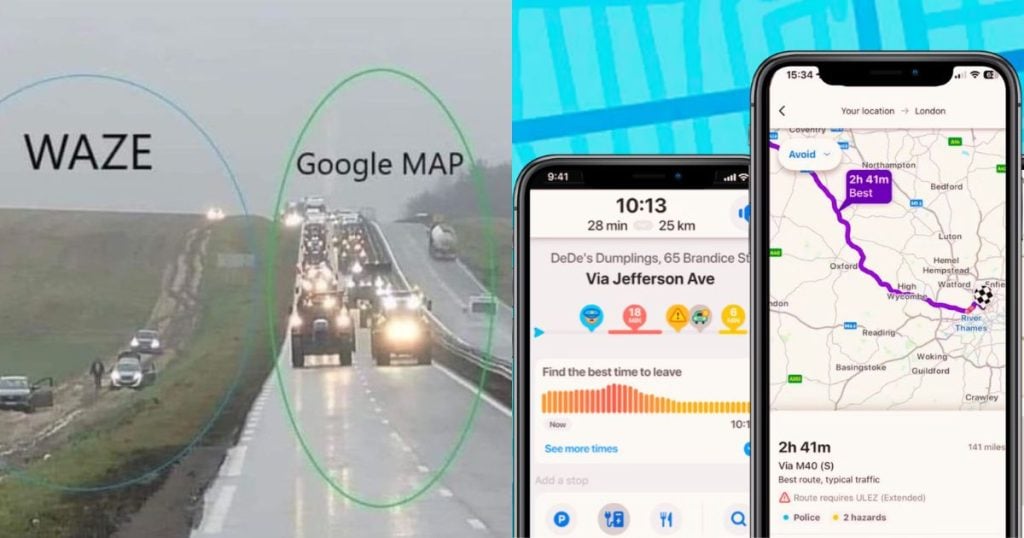5 Reasons Why Die-Hard Fans Believe Waze Still Crushes Google Maps
In the epic battle of the navigation apps, Waze and Google Maps have been duking it out for years to win the hearts (and screens) of drivers everywhere. While both apps are popular and effective at getting you from point A to B, Waze continues to have a legion of passionate supporters who believe it reigns supreme.

Let’s take a closer look at 5 reasons:
Superior Real-Time Alerts and Warnings
One of Waze’s biggest advantages is its hyper-local real-time alerts about road hazards, accidents, police presence, and more. A Pixel 7 forum user in Lisbon, Portugal, noted that “90% of the time I pass by a cop or a car stopped on the shoulder, Waze will warn me about it.”
In contrast, he found that Google Maps rarely provided such warnings during a week of testing, even when he reported the issues.
Waze’s audio alerts are also more helpful, clearly stating the specific hazard, while Google Maps only provides a generic audio signal that requires looking at the screen for details.
For many drivers, especially those frequently navigating unfamiliar areas, these real-time crowdsourced alerts provide immense value and peace of mind.
Smarter Lane Guidance
Another key differentiator is Waze’s superior lane guidance. One user highlighted that Waze “constantly makes sure you are in the correct lane” even when going straight, showing and telling drivers which lanes to use. Google Maps, however, often only shows lane info for upcoming exits or splits.
Waze also has a leg up on roundabout navigation, displaying the exit number on screen in addition to providing audio cues. Google Maps only shows an arrow that may not accurately reflect the angle of the exit.
For drivers who appreciate proactive lane guidance, Waze comes out ahead.
Accurate Speed Limits and Toll Prices
Waze garners praise for showing speed limits on 99% of roads, while some users report Google Maps never displaying this info, possibly due to regional restrictions.
Waze also provides precise toll prices, a handy feature for budget-conscious road trippers. Google Maps acknowledges tolls but doesn’t specify the amount.
More Natural Sounding Audio Directions
Many users prefer Waze’s audio directions, finding the voice smoother and easier to understand compared to Google Maps, which some describe as either too loud or too quiet. Waze allows for better volume adjustment relative to music streaming, creating a more seamless audio experience.
Room for Improvement
While Waze has its strengths, Google Maps devotees point to its sleeker user interface as a deciding factor. One user, who has extensively compared the two, found Google Maps consistently provided “more pleasant driving experience, from the type of roads I had to take to the type of turns I had to make.”
Some argue that Waze’s cluttered interface and occasionally overzealous re-routing to save a minute or two can be more distracting than helpful.
At the end of the day, both Waze and Google Maps are highly capable navigation aids with unique benefits. Die-hard Waze fans, however, remain convinced their app of choice still has the edge where it counts – on the road.
As one user passionately declared, “Waze for years now and will never switch…Coupled with the warning and letting me report stuff on the fly is just soooo much better.”
User Comments:
“I’ve used both extensively and always come back to Waze. The real-time alerts and lane guidance are game-changers. I feel safer and more prepared with Waze.”
“Google Maps is great for finding businesses and destinations, but Waze rules the actual navigation experience. The crowdsourced data is unbeatable.”
“I love how easy it is to report hazards, closed roads, and traffic conditions in Waze. It makes me feel like I’m part of a community looking out for each other.”
“Unpopular opinion, but I actually prefer Google Maps overall. The interface is cleaner and I find the directions more straightforward. To each their own!”
“Waze’s quirkiness and superior alerts have won me over. It may not be perfect, but it feels more human and responsive to real-world conditions.”